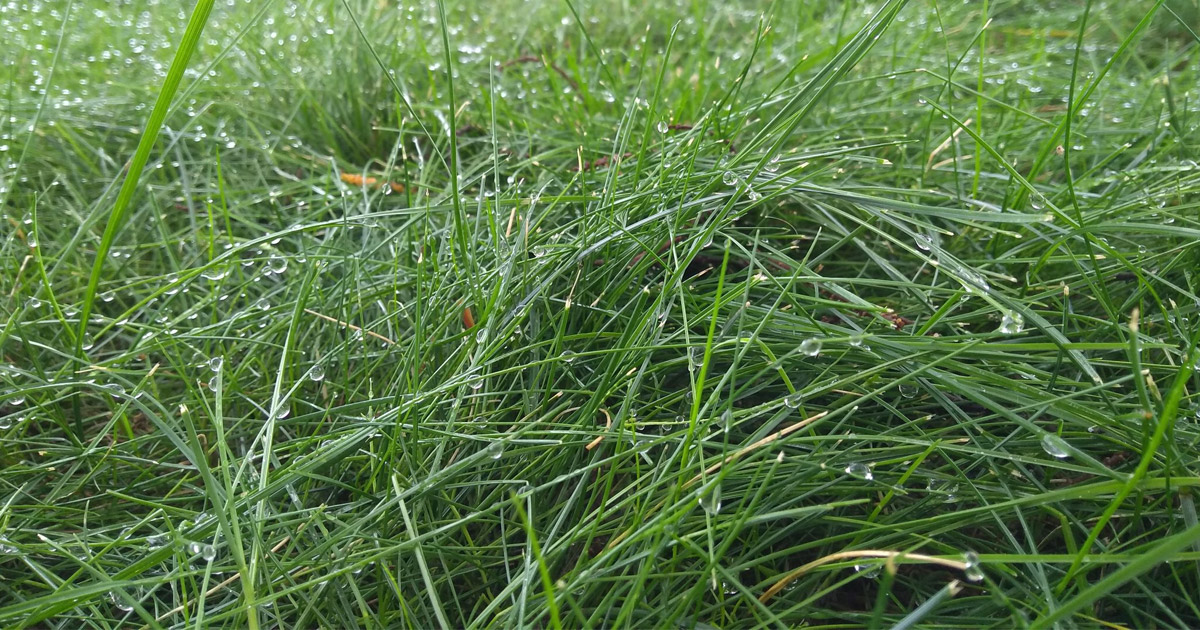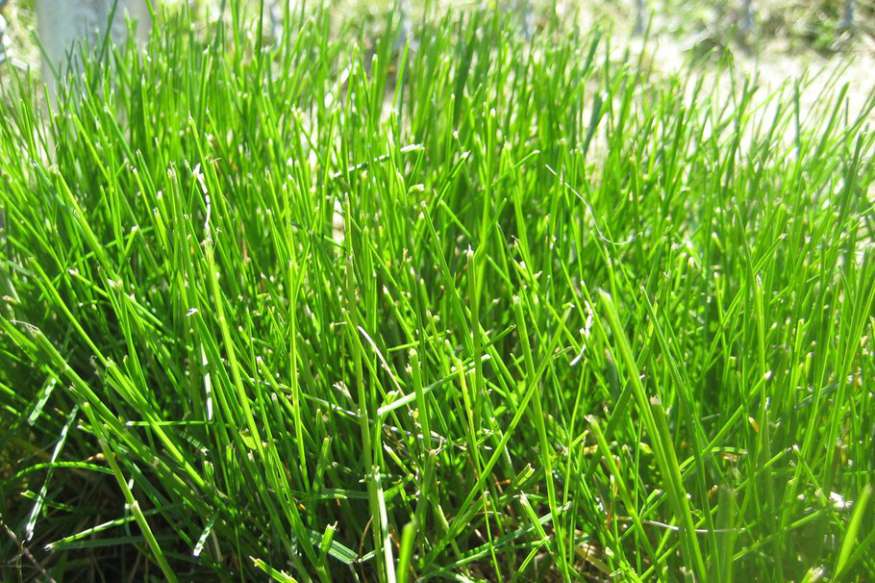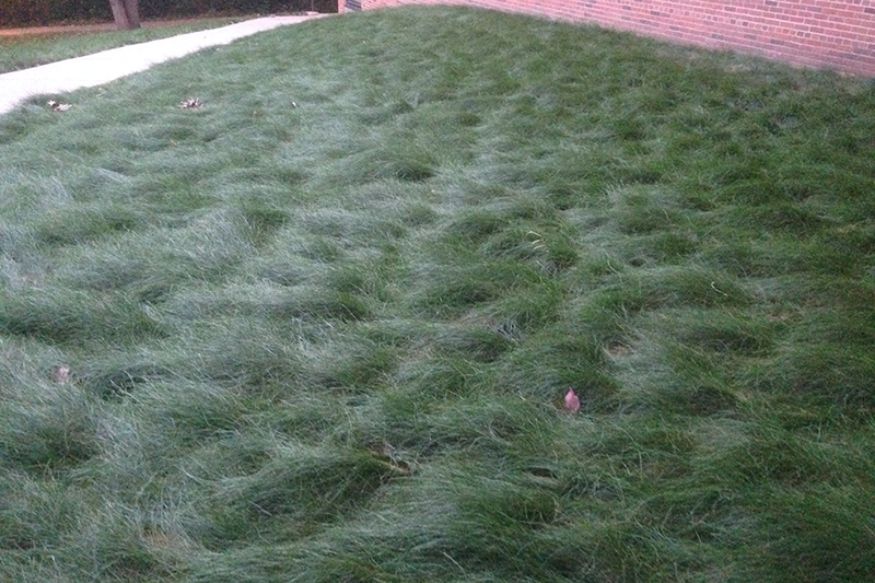Fine fescues have a needle-thin texture and a less-than-desirable appearance. But their impressive shade tolerance and ability to bounce back from stress make them common components of cool-season grass mixtures. In fact, if your northern lawn contains a mix of grass species, you can be sure fine fescue is present.
In this guide, we’ll look at the different types of fine fescues and their characteristics to find out if they’re a good choice for your lawn mix.
We’ll also share everything you need to know to maintain your lawn throughout the year using our fine fescue lawn care calendar.

Tall Fescue Overview
| Also Known As | Hard fescue, strong creeping red fescue, slender creeping red fescue, sheep fescue, chewings fescue; Festuca L. |
| Type of Grass | Cool season perennial |
| Optimal Zones | Northern zones |
| Root Structure | Medium |
| Winter hardiness | Excellent |
| Shade tolerance | Excellent |
| Water Requirements | Medium to High |
| Drought Tolerance | Excellent |
| Self Repair Capacity | Limited |
| Overall Maintenance Requirements | Low |
The History of Fine Fescues
The designation of fine fescue generally refers to five different grass species:
- Hard fescue
- Strong creeping red fescue
- Slender creeping red fescue
- Sheep fescue
- Chewings fescue
These species are native to the Northern hemisphere, specifically North America, Europe, and Northern Asia.
Different types of fine fescue have been used in the turf industry since the 1500s. They were first used in Europe but spread quickly to other cool, humid regions where they grow particularly well.
Fine fescues became popular due to their high shade, drought, and salt tolerance. Their ability to tolerate a variety of mowing heights, from 5 mm and up, makes them popular for use on golf courses, as well.
What has always held fine fescues back as turfgrasses is their appearance. Compared to most cool-season grasses, they are much finer and not as green.
Because of their strengths and their weaknesses, fine fescues are used almost exclusively in turf seed mixes. These mixes typically also include Kentucky bluegrass, perennial ryegrass, and sometimes tall fescue. The only time you typically see fine fescue used exclusively is for “no-mow” lawns.
Fine Fescue Characteristics
Fine fescues have a lot of characteristics that make them worth including in your lawn mix or seeding as the sole grass in your yard. But they also have a lot of drawbacks that you’ll want to know about ahead of time.
To help you decide if fine fescue is right for your yard, let’s take a closer look at the characteristics of these species.
Type of Grass
Fine fescues are all perennial cool-season grasses. “Perennial” meaning they come back every spring. And “cool season” meaning they do most of their growing when temperatures are below 75 degrees.
Like Kentucky bluegrass and perennial ryegrass, fescues grow the most in the spring and fall. In mild climates, they can grow throughout the summer and winter as well.
Varieties of Fine Fescue
There are four varieties of fine fescues that are commonly used as turfgrass:
- Creeping red fescue
- Cherwings fescue
- Sheep fescue
- Hard fescue
While all these varieties have their own subtle characteristics, this guide will cover the species as a whole.
Optimal Zones
Tall fescues are optimal for use in mild northern climates. But their high tolerance for drought, heat, and cold means they can also be used in transition zones.
The caveat here is that these grasses lose color when stressed. For this reason, tall fescue, which is also very hardy, is a better choice for southern transition zones.
Root Structure
The roots of fine fescues do not grow as deep as tall fescues. These grasses also struggle more with root problems. Specifically, dense thatch buildup can prevent penetrating root growth, causing a host of problems for your lawn.
However, when the grass is well maintained, it tends to be highly drought tolerant. It will need about as much water as other cool-season species to stay green but can survive longer periods without water.
Note: During times of drought, it will go dormant and turn brown.
Winter Hardiness
Fine fescues are fairly cold-hardy and can survive freezing temperatures in the winter. They will turn brown and go dormant as soon as nighttime temperatures drop below 50 degrees. These are persistent grasses that will often outlive the others in the mix.
Shade Tolerance
Fine fescues are widely considered the most shade tolerant of all cool-season species. They grow well in full shade and full sun. Turf seed mixes marketed specifically for shade contain mostly fine fescue seed.
Water Requirements & Drought Tolerance
Like most cool-season grasses, fescue requires about 1 inch of water per week in mild weather. Without adequate water, they will lose color. If more than a few weeks pass without water, they will go fully dormant.
Of the fescue species, sheep and hard fescue are the most drought-tolerant. In the summer, providing ¾ inch of water every 3 weeks is enough to keep the grass alive until it can green back up in the fall. To keep grass green through the hotter months, you must provide 1 to 2 inches of water per week.
Self Repair Capacity
Fine fescues have a medium tolerance to wear. But they are not a good option for high-traffic areas because of their limited capacity for self-repair.
Creeping red fescue is the only species of fine fescue grow rhizomes while the others are strictly bunching. But neither type will grow back well after being worn to the dirt.
Fine Fescue Lawn Care Calendar
As usual, special attention to lawn care is required for fescue lawns, as they require year-round care to look their best.
For new fine-fescue-only lawns, seed at a rate of 3.5 to 6 pounds of seed per 1,000 square feet. Most fescue mix blends will have a different seeding rate. In this case, follow the directions on the bag.
Note: Fall is the best time to spread fine fescue seed.
Alternatively, you can set seed in the spring as soon as winter temperatures begin to warm. Sprouts take 5 to 12 days to germinate.
Once the seedlings have reached 2 inches in height, you can begin following our fine fescue lawn maintenance plan, below.
Spring Care
Fine fescues grow the most in the spring. Because of this, you’ll have to do the most maintenance this time of the year.
Mowing
Fescue is very tolerant of different mowing heights, but it performs best at heights between 2 and 3 ½ inches.
In the spring, start mowing as soon as the grass begins growing. Most fine fescues have a moderate growth rate and will need to be mowed once per week. However, you’ll want to adjust this as needed to assure you’re taking no more than ⅓ the blade height off at a time.
For areas of deep shade, leave the grass a little longer (3 ½ inches) to allow for maximum photosynthesis.
Fertilization
Fine fescues can survive in low-nitrogen environments better than most grass species. Mature lawns will typically only require fertilization in the fall. However, if your grass has a lackluster color or begins to brown before temperatures rise, this is a good sign you need to fertilize.
For spring fertilization, apply between ½ and 1 pound of nitrogen for every 1,000 square feet. We recommend a relatively balanced nitrogen-phosphorus ratio this time of year to support adequate leaf and root growth.
Weed Control
Apply a pre-emergent weed control option early in the spring. Use spot control weed killers on young weeds as soon as they sprout or pull them manually.
Thick, healthy fescue rarely has weed problems. For new or thin lawns where weeds are a problem, keep tall fescue longer (about 3 inches) to help crowd out weeds through the spring.
Watering
For a lush lawn, aim for 1 inch of moisture per week. Irrigation is not typically necessary during the first months of spring in most climates. As natural rainfall decreases, begin watering three times per week.
Watering in the early morning is generally the best time. This period reduces water loss while restricting how long foliage stays wet to avoid fungus problems.
Watch for excessive water runoff with mature lawns. This is typically a sign of thatch buildup.
Pest and Disease Control
Fescue is relatively disease resistant. However, some species are more prone to certain problems than others. One of the best ways to address recurring issues is to overseed with the species that are performing the best in your particular microclimate.
Strong creeping red fescue, for instance, is fairly prone to red thread. Meanwhile, hard fescue and sheep fescue are rarely plagued by this problem.
Insects rarely cause issues for fescue lawns.
For both funguses and pests, use a targeted control method only when signs of damage are seen.
Aeration and Dethatching
Aerating should be done now if it was not completed in the fall. Do it once spring growth is at its peak. This will allow your grass time to recover before the hot summer temperatures.
Tatch can be a serious problem for fescue. If not maintained, it will cause water and nutrient absorption problems and prevent roots from penetrating into the ground.
Creeping fescues are the most likely to cause issues with tatch, especially when planted with Kentucky bluegrass. These lawns should be thoroughly dethatched every 2 to 4 years. This can be done in April or May, but is better saved for fall maintenance.
Summer Care
Because fine fescues are cool-season grasses, they do not grow much in the summer. Ifthe conditions are too hot and dry, they may even go dormant and turn brown. Summer maintenance is largely centered around ensuring your lawn gets what it needs to bounce back in the fall.
Mowing
For hot conditions, set your mower height to 3 1/2 inches in the summer. This will help prevent sunscald and reduce stress as grass transitions into dormancy.
Growth will slow considerably as the temperature rises over 75 degrees. Reduce mowing frequency to avoid overstressing the grass. In the heat of the summer, you may only have to mow once every other week or less.
Watering
To keep grass green throughout the summer, continue applying 1 inch of water per week in three watering sessions. As temperatures increase, you will need to increase watering to 2 inches per week.
In hotter climates, it is much more economical to let your fescue go dormant. To do this, slowly reduce watering to ½ to 1 inch applied in multiple watering sessions every three weeks.
Keep in mind that other grasses in your mix may not be as tolerant to drought. To keep them thriving you may need to water your lawn more often.
Pest Control
Cinchbugs and white grubs can be a problem in the summer, especially in stressed lawns. Look for damage and treat with a targeted curative method as needed.
Note: White grub control must be applied before August to be effective.
Overseeding
For new lawns that went dormant over the summer, you may want to overseed your lawn in August. This will help fill any dead spots that do not come back.
Because fine fescue is so drought tolerant, mature lawns rarely require this. However, other grass species in the mix may require reseeding if they did not survive the dry summer. Patchy regrowth as summer ends is a good sign that this was the case.
Fall/Autumn Care
The fall season is all about preparing your lawn for winter. This means making sure it gets enough nutrients and the right care to survive dormancy and come back stronger in the spring.
Mowing
Cut your lawn to any height between 2 and 3 ½ inches during the fall season. Fine fescue yards struggling with weeds this time of year will benefit from a higher maintenance height.
Mow as often as needed (every 7 to 10 days, on average) to avoid cutting more than ⅓ of the grass blade each mowing. Continuing mowing until growth stops.
Fertilization
Fall is the best time to have your soil tested to find out what nutrients are lacking. Choose the right fertilizer to supply these nutrients and apply it in September and again in early October.
This is also the best time to apply a high-nitrogen fertilizer on fine fescue lawns. Apply this in September at a rate of ½ to 1 pound of nitrogen per 1,000 square feet. For lawns that experienced high stress over the summer, repeat the treatment in early October.
Alternatively, you can apply a special winterizer fertilizer during this second application. This is especially beneficial in climates that experience long or harsh winters.
Weed Control
Continue using spot control or manual control methods to eradicate weeds. When maintained at a height of 3 inches, most fine fescue lawns do not struggle with weed problems.
This is the best time of the year to apply broadleaf herbicides for dandelion control. Spraying will reduce weeds now and reduce the number of weeds that germinate in the spring.
Watering
Once temperatures begin to drop at the beginning of fall, start watering as needed to give your fine fescue 1 inch of water per week. Gradually decrease watering to ½ an inch per week starting in mid-October.
Keep an eye on precipitation accumulation after your irrigation system has been winterized. If it’s a dry fall, you may want to hand water to reduce winter stress.
Pest Control
As you did in summer, treat pests only on an as-needed basis. Blanket pest control options are not as effective as targeted measures. Luckily, fine fescue is fairly resistant to insects.
While this is a great shade grass, Powdery mildew can show up in shaded areas with excess bluegrass seed. Cut trees and bushes to increase airflow and overseed these areas with fine fescue before winter.
Aeration and Dethatching
Fall is a great time to have your lawn aerated to avoid compact soil if you didn’t do so in the spring. Aerated soil is better able to accept nutrients and water, making for a greener start to the new year.
Have your lawn aerated before spreading your nitrogen-rich fertilizer. This will increase nutrient absorption and give your lawn the best chance of coming back strong in the spring.
This is also the best time to dethatch your fine fescue lawn. This should be done every 2 to 4 years or when water absorption becomes a problem. Dethatch in September once your grass begins growing vigorously following summer dormancy.
Overseeding
Fall is the best time to overseed your lawn, if needed.
Fine fescues included in mixes tend to dominate the lawn after only 2 to 3 years. Overseeding with the non-fescue cool season grasses originally present in the mix can help rebalance your lawn. We recommend adding Kentucky bluegrass or perennial ryegrass for a lusher, greener yard.
Overseeding can be done as soon as fall arrives. Do so no later than 45 days before the first frost in order to give new sprouts time to establish.
Winter Care
In most climates, fine fescue will go dormant through the winter. It will not need much maintenance until it begins to green back up in the spring.
Watering
Watering is typically not needed in the winter. But, if you are experiencing a particularly dry cold season, you may have to hand water on occasion. Shoot for about ½ to 1 inch of moisture every 3 weeks when temperatures are above freezing.
Overseeding
If you missed your window to overseed in the fall, you can do so in late winter. The best time to do this is February when the ground is still moving through thaw and freeze cycles. This will help pull the seed into the soil.
This time of year is perfect for spreading any type of cool-season grass. This includes all species of fine fescue, tall fescue, Kentucky bluegrass, and more. The seeds will begin to sprout just as your mature grass starts to green up in the spring.

